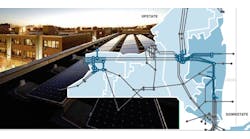Energy storage as solution to NYC power shortfall
Thirty percent of New York City’s old fossil fuel plants are slated for retirement in the next five years. Could energy storage take their place?
A new report, “New York City’s Aging Power Plants: Risks, Replacement Options and the Role of Energy Storage,” says it would be a wise environmental move.
Issued by the New York Battery and Energy Storage Technology Consortium (NY-BEST), in partnership with Strategen Consulting, the report says that using batteries could reduce ozone-forming pollution by more than 60 percent and greenhouse gas emissions by more than 75 percent – all while cost effectively maintaining grid reliability.
Batteries could help the city solve another big problem too. New York faces a potential power shortfall as early as 2021 because there are not enough power projects in planning to replace the 2,860 MW retiring, according to the report.
Energy storage is an economically viable alternative, according to the report, which found that the city’s electricity customers spend more than $268 million annually to support old peaking plants that run for just a few hours each year. A five percent set-aside of this amount could attract investment in more than 450 MW of new energy storage resources over the next five years with very little impact (<1%) in total cost to customers, the report said.
Duke Energy plans two big batteries for North Carolina and more to come
Duke Energy plans to install North Carolina’s two largest battery energy storage systems – a $30 million investment – to improve reliability and efficiency.
To be installed in Asheville and Madison County, the batteries are the first in a larger plan by Duke Energy to deploy energy storage for the region.
A 9-MW lithium-ion battery system in Asheville will be placed at a Duke Energy substation in the Rock Hill community. The battery will be used to help the electric system operate more efficiently and provide energy support to the electric system, including frequency regulation.
In Hot Springs, a town in Madison County, the utility will install a 4-MW lithium-ion battery system to improve electric reliability and serve the overall electric system. Duke also considering an accompanying solar facility.
States still green even as feds backtrack: S&P
States with Renewable Portfolio Standards and Goals (PRNewsfoto/S&P Global Market Intelligence)
Even as the U.S. federal government back tracks on climate plans, the states are driving forward with solar, wind, and energy storage, according to S&P Global Market Intelligence.
“Our coverage has shown that states are taking a proactive approach in reaching renewables portfolio standards, despite the shift in focus from policymakers at the federal level,” said Nick Kapur, senior director of energy at S&P Global Market Intelligence.
Even though the trend towards clean, distributed, and mobile energy resources is well underway, the industry is still figuring out best models and regulatory processes, and how to establish new infrastructure requirements needed to power the grid of the future, according to Kapur.
Track energy storage news by subscribing to the Microgrid Knowledge newsletter. It’s free.







